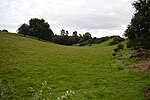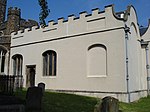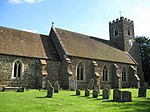The present St Mary's Church is located in the centre of the small village of Clophill, between Bedford and Luton in the South Midlands of England. The new church, built in 1848, replaced the old church by order of the Church Commissioners in 1850. The old church building, formally The Church of St Mary The Virgin (shortened to The Church of St Mary) and known colloquially as Old St Mary's or The Old Parish Church, is at the edge of the village, and is estimated to be around 650 years old. It sits at the crest of the Greensand Ridge, offering views over the surrounding countryside. Its graveyard is a haven for wild flowers and wildlife. After the church moved to the village centre, incorporating various items from the old church building, the old building was converted for use as a mortuary chapel, but in the 1950s it fell into ruin.
The Church of England no longer has responsibility for the Old Parish Church, nor is it deemed to be consecrated; legally it is the responsibility of Central Bedfordshire Council. It acquired first local, then more widespread, notoriety in the 1960s, as a result of the desecration of a number of the church's graves, with the attendant sensationalist suspicions of Satanism and black masses. In 2010 Central Bedfordshire Council, prompted by local activists concerned with the condition of the church, announced it would attempt to restore the Old Church and adopt it for use as a bothy on a regional walking trail. Those plans proved too expensive for the council; instead, in 2012 a new project was announced, which included stabilising the existing ruin and providing a viewing platform on the top of the tower, besides building a heritage centre next to the church.










